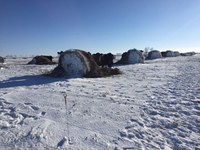Now is the time to think ahead for fall bale grazing
(Click the image below to view a high-resolution image that can be downloaded)
Despite the heat of summer, many ranchers are thinking ahead to fall and preparing to winter their cowherds. The first cutting of hay has been completed in many areas and ranchers are moving bales from the field to the lot for storage until they are fed.
This period of bale transport is a great time to set up areas for bale grazing, say North Dakota State University Extension specialists.
“Moving bales from the field straight to the area where they will be fed saves an extra step in bale movement and machinery costs,” says Zac Carlson, NDSU Extension beef cattle specialist.
“The concept of bale grazing is simple,” says James Rogers, Extension forage crops production specialist at the North Central Research Extension Center. “Place bales in a grid pattern in the area that they will be fed in. Then, install electric fence in a manner to allow access for two to three days of feeding. Continue to allow two to three days of bale feeding by leapfrogging the electric fence across the bale grazing area.”
“Bale grazing is a good way to reduce manure handling, and add nutrients and organic material to a needed area,” shares Mary Keena, Extension livestock environmental management specialist at the Carrington Research Extension Center. “It also allows cattle to self-feed, reducing the labor of daily feeding.”
Carlson, Keena and Rogers offer several considerations to make bale grazing successful.
- First, consider how many bales will be needed. This is determined by nutritional demand, the number of head and the desired length of time for bale grazing. For example, the 90-day period after weaning can be an optimal time for bale grazing because it is a time of low nutritional demand for the cow, which can be met by a fair to good quality hay. Do not forget to include bale waste. Rogers says a good estimate for bale waste is 20%, but it will vary depending on the area used for bale grazing, bale density and quality, bale access space and animal behavior.
- Forage test each hay lot, defined as similar species harvested from the same hay field within 48 hours, and allocate hay based on nutrient content and nutritional demand. You can stage bales based on quality and leave higher quality hay for cows in late gestation or early lactation.
- Selection of the area to be bale grazed is important. Bale grazing can be conducted on introduced perennial pasture, hayland or crop ground but the effects on each will differ. Bale grazing creates a concentration of nutrients and hoof action around each bale. These effects require consideration when choosing the area to bale graze. Select an area that will benefit the most from the addition of these nutrients. Perennial pasture areas with sod-forming grasses will hold up better than bunch-type grasses. Avoid areas where excess nutrients can flow into streams and ponds. Areas that can provide natural wind protection are advantageous.
- If possible, use multiple locations for bale grazing over time in order to reduce nutrient concentration in one area. Use soil testing to monitor changes in soil fertility over time.
- Hay bales move nutrients and seed from one location to another. If hay is contaminated with weed seed, such as foxtail barley, be mindful of areas where you do not want the weed to establish.
- Place bales where all cattle can have equal bale access. Setting up bales on a 40-by-40-foot grid will work well and can lead to more uniform manure distribution.
- Fencing and water access are important. Electric fencing provides the flexibility to make bale grazing work. Two strands of hot wire may be required to prevent cattle from pushing into yet-to-be grazed bales. If cattle have no experience with electric fence, train them to it prior to turning onto the bale grazing area. If the ground is frozen, use the bales as an area to drive posts into for the fence. Make sure that cattle have easy and adequate access to water.
- Handling bale twine and wrap can be the most challenging issue with bale grazing. If sisal twine is used, place the bale on its side, and the twine will deteriorate and not be an issue. Polypropylene and net-wraps will not deteriorate and will pose a problem if left on the bale. One strategy is to set bales on end and remove wrapping as needed, which works, but anticipate more moisture seeping into the top and bottom of the bale, which can increase spoilage.
For additional information on winter feeding strategies, view the NDSU Extension publication “Alternative Winter Feeding Strategies for Beef Cattle Management” at ndsu.ag/winterfeeding or contact your county NDSU Extension agent.
NDSU Agriculture Communication – Aug. 2, 2023
Source: James Rogers, 701-857-7682, james.rogers.1@ndsu.edu
Source: Zac Carlson, 701-231-1884, zachary.e.carlson@ndsu.edu
Source: Mary Keena, 701-652-2951, mary.keena@ndsu.edu
Editor: Kelli Anderson, 701-231-7881, kelli.c.anderson@ndsu.edu


